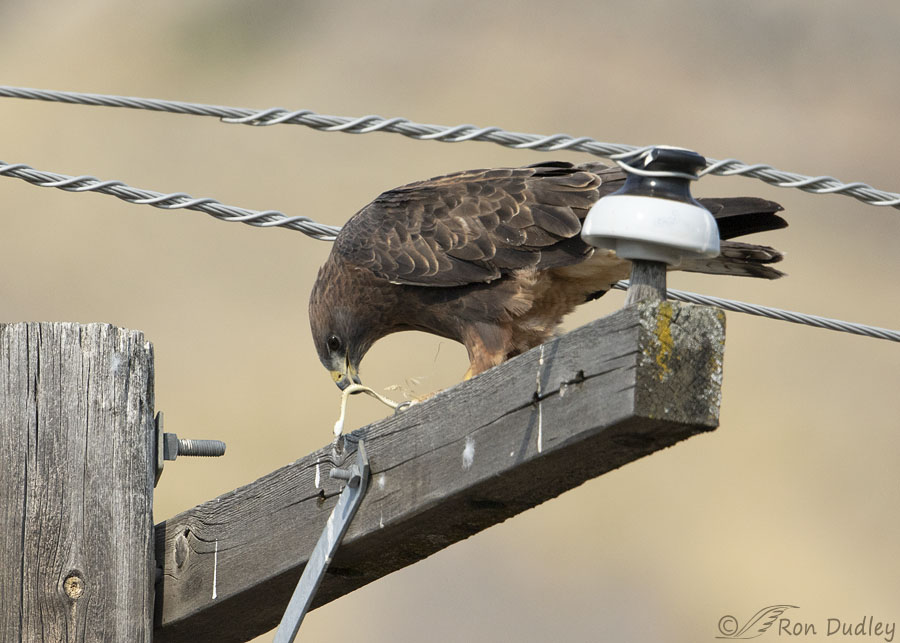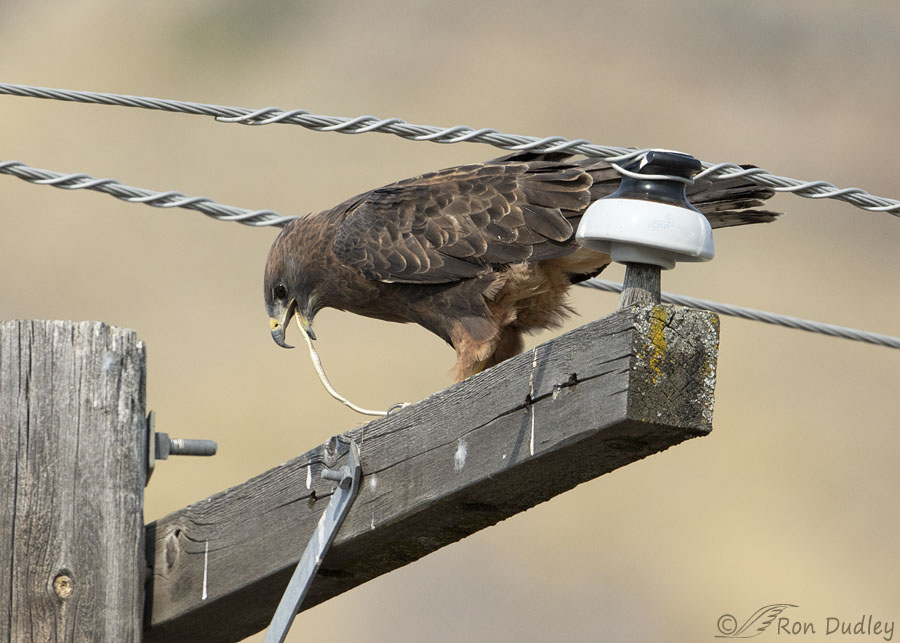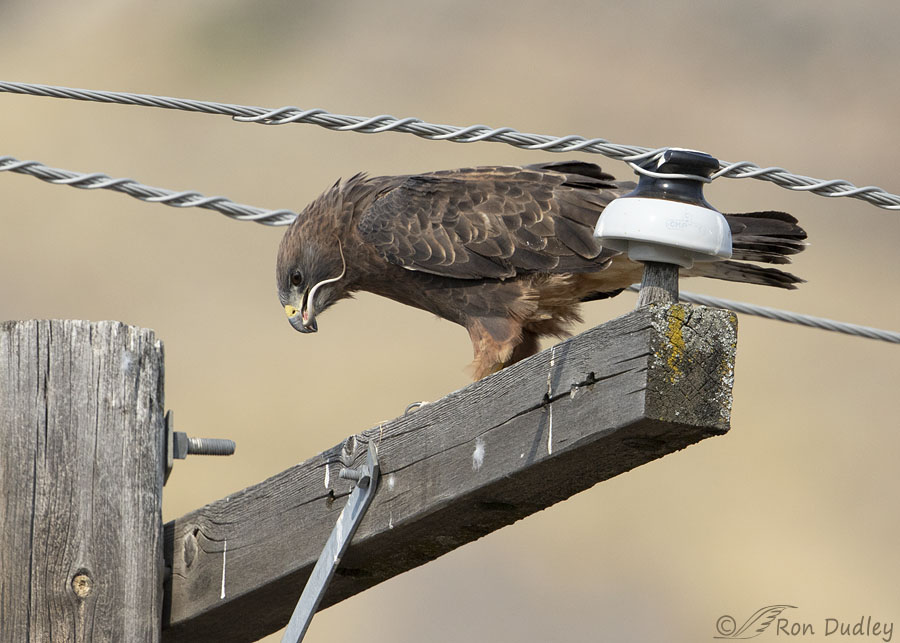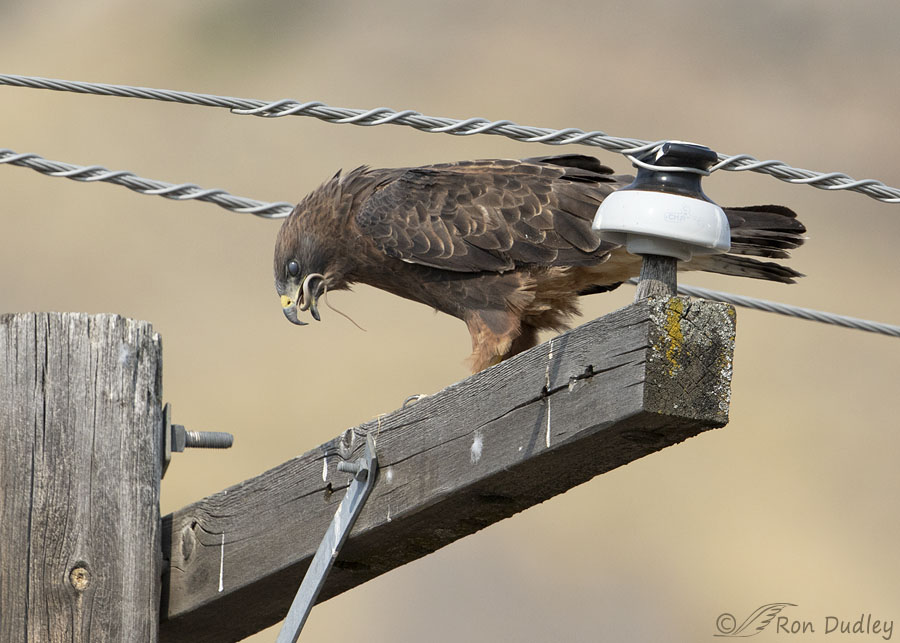The last Swainson’s Hawk I photographed this year turned out to be more interesting than I initially thought it was.
As I mentioned on another recent post I seldom stop my pickup for hawks perched on utility poles. But a little over two months ago as I approached this dark morph Swainson’s Hawk on a pole in Box Elder County I could tell ‘he’ had prey of some kind so out of curiosity I checked him out with my lens.

1/3200, f/6.3, ISO 500, Canon 7D Mark II, Canon EF 500mm f/4L IS II USM + EF 1.4 III Extender, not baited, set up or called in
Even through my long lens I didn’t immediately identify the prey as a small snake. At first I thought he was tugging on intestines of a small mammal in his talons that I couldn’t see. If they were intestines they seemed unusually white but I didn’t think much about it until my session with him was over and I zoomed in on my photos on my camera screen in the field. Until then I had no idea it was a snake.

1/3200, f/6.3, ISO 500, Canon 7D Mark II, Canon EF 500mm f/4L IS II USM + EF 1.4 III Extender, not baited, set up or called in
He used a very similar technique to eat the snake as he would for intestines so I was completely fooled. I half expected him to deliberately drop the “intestines” since raptors often reject mammal intestines before consuming the rest of the animal but this guy…

1/3200, f/6.3, ISO 500, Canon 7D Mark II, Canon EF 500mm f/4L IS II USM + EF 1.4 III Extender, not baited, set up or called in
gobbled down the entire food item. Even when he got to the tapered tail I didn’t recognize it as a snake. With my shutter slapping in front of my eyes as I fired quick bursts my view of him was often interrupted and at the time my only concern was to keep him in frame and in focus.

1/3200, f/6.3, ISO 500, Canon 7D Mark II, Canon EF 500mm f/4L IS II USM + EF 1.4 III Extender, not baited, set up or called in
As birds typically do whenever anything threatens their eyes he closed his nictitating membrane when the snake’s thrashing tail got too close to his left eye.
I can’t ID the snake as to species with any confidence but every snake I’ve seen in this area over the years has been a gopher snake so if I had to guess I’d go with the odds and say that’s what it was. Most gopher snakes have creamy bellies like this presumed baby gopher snake. But I won’t rule out some other species of snake, in part because it seems so light colored.
Part of the reason I’m interested in this photo series is that I’ve never before seen a Swainson’s Hawk eating a snake. I’ve photographed Red-tailed Hawks eating snakes and American Kestrels with snakes as prey but never a Swainson’s Hawk. In the past I’d only seen them eating grasshoppers and voles.
But Cornell’s Birds of the World reports on a study in Washington state where 20% of the diet of Swainson’s Hawks in that area consisted of reptiles so I shouldn’t be surprised.
Ron
Note: While composing this post I had a brain fart. Six years ago I actually did photograph a Swainson’s Hawk eating a snake but I’d forgotten about it. If you follow the link it’s the last photo in the series but the rest of them are pretty interesting too.


Wow…what an exciting series of stories! Thank you all!
Interesting that the Swainson’s is eating the snake “spaghetti style” and not tearing off pieces. I wonder if that’s the same procedure for larger snakes or if they dispatch and tear.
The moving snake makes me think of the spider verse in this song: https://www.youtube.com/watch?v=lZzFVnB_L5A
Marty, in my experience raptors nearly always eat snakes “spaghetti style” although I’m not sure about kestrels, for obvious reasons related to relative size.
I’m pretty sure that old lady really is dead.
One of the funnier experiences I had up that way was a young redtail trying to eat a gopher snake, the snake had completely wrapped around the birds feet and legs hog tying it. The bird flapped and lost balance, staring at it’s feet but the bird would not let go of the snakes’s head in it’s beak. It was a big mature snake!
Now that would have been fun to photograph! Hope you got some photos, April.
nope, before the day of intensely trying to capture it.
Well at least you have the apparently vivid memories.
Your usual incredible series. HOWEVER. I followed the link (of course) to yet another stunning series. I am at the moment wrestling with medication induced nausea – which has ramped up several notches. My morning cuppa will have to wait.
Sorry, EC. That kind of thing never bothers me so I didn’t even think of providing a warning of some sort. Nausea is no fun…
Not a problem. Because I love and learn from your photos I would have gone anyway. And no, nausea (virtually constant) is not a lot of fun.
As in the past posts you link to, it appears hunger overtakes other considerations to want to devour a snake. it just doesn’t look like the birds are particularly enjoying the process.
In the third photo it is interesting how the snakes tail and the wing feathers have a similar curve.
Lyle, my guess is that they have less practice with snakes than they do with other prey so they’re being particular careful about potential injury. Handling the long bodies of snakes would probably seem unfamiliar and awkward to them, not to mention the potential danger.
Everett and Ron, I gotta admit that when Mariah decided she didn’t like snakes anymore, I was DELIGHTED! If I remember correctly, she caught three rattlers but it was (maybe) a bull snake in Wyoming that tried to kill her back. When I caught up to her the snake had wrapped itself around her neck several times. As is in my falconer job description (I’m in charge of all emergencies), I unwound the snake and she won the battle. After that one, she ignored snakes ever after.
What a BEAUTIFUL Swainson’s! Then again, I’ve mentioned that I’m a fool for the dark morphs 😉
Aren’t brain farts fun…sigh!
Sounds like Mariah’s a fast learner, Laura. Good thing, you don’t get many second chances with rattlers. Glad you survived the encounter too.
Super series Ron! Thanks 7!
Charlotte Norton
Thank you, Charlotte.
Interesting and also a bit disgusting at the same time until I was clear on what it was – thought it was puking initially – something I don’t do well with! 😉 Yes, those precious eyes DO have to be protected! Whatever kind of snake it was sure appears on the skinny side except for the one “bulge”..
“thought it was puking initially – something I don’t do well with”
Then don’t follow the Swainson’s Hawk link in my “Note”, Judy. Fair warning… 🙂
Interesting series. I think that because Swainsons spend considerable time foraging on the ground they are bound to find more snakes than most. The Common Black Hawks here catch snakes that reside close to our creeks. I have seen eagles and hawks flying with snakes, but never have had the opportunity to see one eating the snake. A woman I chatted with near our Willow Lake years back told me about a Red-tailed hawk that swooped down to grab a rattlesnake and missed thus becoming the prey itself. She said it was not a pretty picture to watch.
Everett, I think many of us have seen videos of red-tails attacking snakes where the snake turned the tables and got the best of the hawk. You’re right, it isn’t pretty.